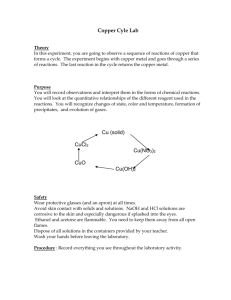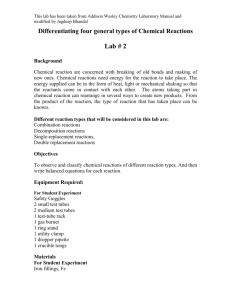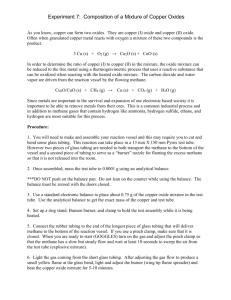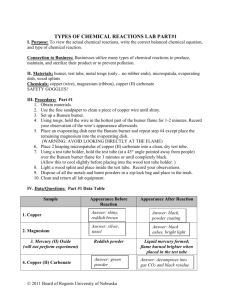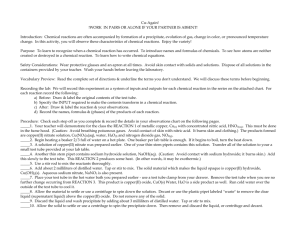Empirical Formula
advertisement
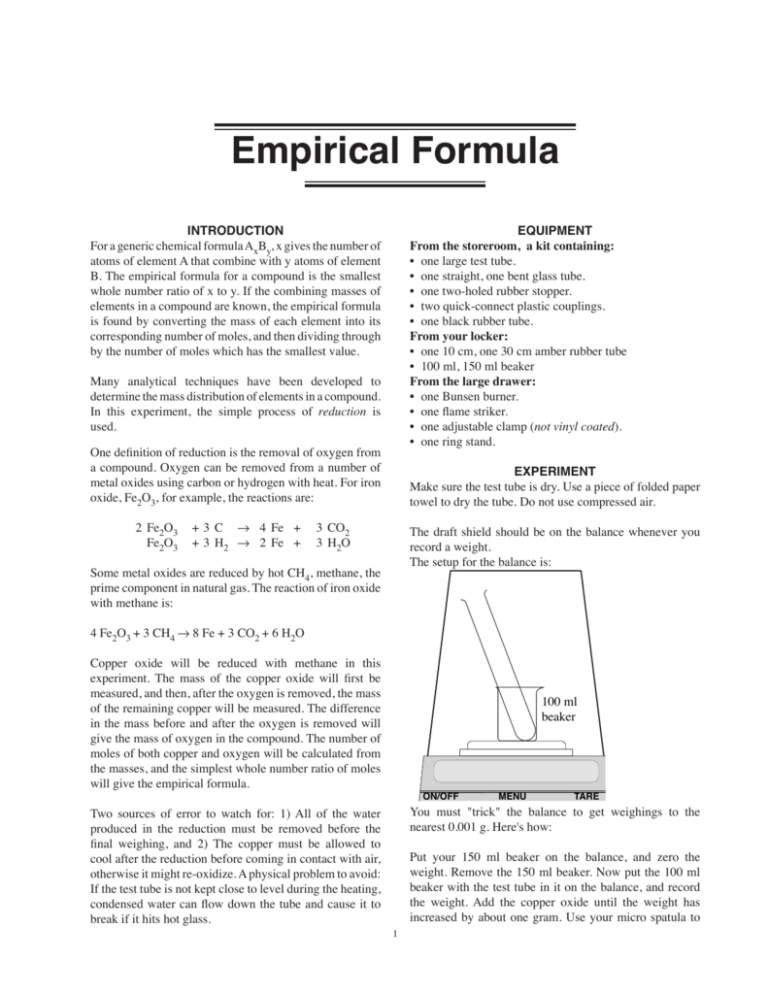
Empirical Formula Introduction For a generic chemical formula AxBy, x gives the number of atoms of element A that combine with y atoms of element B. The empirical formula for a compound is the smallest whole number ratio of x to y. If the combining masses of elements in a compound are known, the empirical formula is found by converting the mass of each element into its corresponding number of moles, and then dividing through by the number of moles which has the smallest value. equipment From the storeroom, a kit containing: • one large test tube. • one straight, one bent glass tube. • one two-holed rubber stopper. • two quick-connect plastic couplings. • one black rubber tube. From your locker: • one 10 cm, one 30 cm amber rubber tube • 100 ml, 150 ml beaker From the large drawer: • one Bunsen burner. • one flame striker. • one adjustable clamp (not vinyl coated). • one ring stand. Many analytical techniques have been developed to determine the mass distribution of elements in a compound. In this experiment, the simple process of reduction is used. One definition of reduction is the removal of oxygen from a compound. Oxygen can be removed from a number of metal oxides using carbon or hydrogen with heat. For iron oxide, Fe2O3, for example, the reactions are: experiment Make sure the test tube is dry. Use a piece of folded paper towel to dry the tube. Do not use compressed air. 2 Fe2O3 +3 C → 4 Fe + 3 CO2 Fe2O3 +3 H2 → 2 Fe + 3 H2O The draft shield should be on the balance whenever you record a weight. The setup for the balance is: Some metal oxides are reduced by hot CH4, methane, the prime component in natural gas. The reaction of iron oxide with methane is: 4 Fe2O3 + 3 CH4 → 8 Fe + 3 CO2 + 6 H2O Copper oxide will be reduced with methane in this experiment. The mass of the copper oxide will first be measured, and then, after the oxygen is removed, the mass of the remaining copper will be measured. The difference in the mass before and after the oxygen is removed will give the mass of oxygen in the compound. The number of moles of both copper and oxygen will be calculated from the masses, and the simplest whole number ratio of moles will give the empirical formula. Two sources of error to watch for: 1) All of the water produced in the reduction must be removed before the final weighing, and 2) The copper must be allowed to cool after the reduction before coming in contact with air, otherwise it might re-oxidize. A physical problem to avoid: If the test tube is not kept close to level during the heating, condensed water can flow down the tube and cause it to break if it hits hot glass. 100 ml beaker ON/OFF MENU TARE You must "trick" the balance to get weighings to the nearest 0.001 g. Here's how: 1 Put your 150 ml beaker on the balance, and zero the weight. Remove the 150 ml beaker. Now put the 100 ml beaker with the test tube in it on the balance, and record the weight. Add the copper oxide until the weight has increased by about one gram. Use your micro spatula to add the copper oxide to the test tube. Record the weight to the nearest 0.001 g. You should have between 0.8 and 1.2 grams of copper oxide in the test tube. After you have heated the copper oxide, repeat the procedure to weigh the copper. Put the 150 ml beaker on the balance, zero the balance, then remove the beaker. Put the 100 ml beaker with the test tube on the balance, and record the weight. See the discussion in the balance handout to see the reason for this procedure. Pay particular attention to the angle of the test tube and the placement of the clamp holding the test tube. Do not use vinyl coated clamps. Refer to the Rubber and Glass handout for instructions on making connections. That discussion will also help you understand why two different kinds of rubber hoses are used. Use significant digits properly when you record data and when you do the calculations. Connect the test tube into the apparatus. Call the instructor to examine the apparatus and initial the data table before you turn on the gas. If all the balances are in use, begin assembling the apparatus until a balance is free. Follow the instructions in the Bunsen Burner handout to get a hot flame. Ask the instructor for help if needed. Tube is s li When the gas is first turned on, it will take a few seconds before it gets through the test tube to the Bunsen burner, so initial efforts to light the flame might fail. Move the flame over the area of the test tube containing the copper oxide. Move slowly and consistently until the black oxide has turned into the red metal. If this has not happened in 15 minutes, call the instructor over for advice. Heat the upper portion of the tube on occasion to allow the water condensing to vaporize. ghtly tilt ed 10 cm amber tubing 30 cm amber tubing After the copper oxide has been reduced, set the burner down away from the tube; turn the air vent down (see the Bunsen Burner Use discussion ) and reduce the gas flow to get a very small, gentle flame. black tubing from kit To Gas Spigot. Red Bunsen Burner Tubing When the tube containing the copper has cooled to room temperature, turn the gas off and remove the rubber stopper, being careful that no condensed water rolls down the tube towards the copper. If there is any water on the upper portion of the tube, wipe it off with a paper towel, then weigh the tube with the copper, using the method described above, and record the weight in the data table. base facing towards you Pay careful attention to the diagram. Your setup should match exactly. Points will be taken off of your grade for this experiment if your setup has substantial deviations from the diagram. Carefully read the instructions in the next column before you start. Return all items to their place of origin and clean up your work space. You may put the copper in a baggie and keep it as a trophy. 2 Instructor's initials, setup OK _______ DATA 1. mass of empty test tube g 2. mass of test tube with copper oxide g 3. mass of test tube with copper g CALCULATIONS 4. mass of copper oxide (data 2 – data 1) g 5. mass of copper (data 3 – data 1) g 6. mass of oxygen (data 2 – data 3) g 7. moles of copper (show work) 8. moles of oxygen atoms (show work) 9. whole number ratio, mol Cu to mol O 10. Formula of copper oxide (experimental) mol mol 3 Name_________________________________________ Grade___________ Date ___________ questions 1. The substance used was copper (II) oxide. Use the name of the substance to write its formula: 2. Look at the calculated number of moles of copper and of oxygen from your data. Subtract the smaller number from the larger number. (Use significant digits properly.) Divide this difference by the smaller number. Multiply by 100. Now write the sentence: “The number of moles of _______ (the larger number of moles substance, either copper or oxygen) was ­___ % larger than a 1 to 1 ratio of moles requires.” (Note that you could alternately say that the smaller number substance was some percent smaller than a 1 to 1 ratio requires.) 3. For each of the following possible experimental errors, state what the effect would be on data entries 1, 2, and/or 3. That is, would the errors make the data entries larger or smaller? Also state whether the error would cause the calculated moles of copper and the calculated moles of oxygen to be too high or too low. • Incomplete reduction of the oxide: • Re-oxidation of the copper after the reduction because of opening the test tube while still hot: • Incomplete removal of the water after the reduction: • Water in the test tube before the first weighing: • Can you think of any other problems that might occur? Did any of these problems occur during your experiment? 4. Write out the balanced equations for the reduction of copper oxide with C, H2, and CH4. (use the reactions shown on page 1 for iron(III) oxide as a template.) 4

